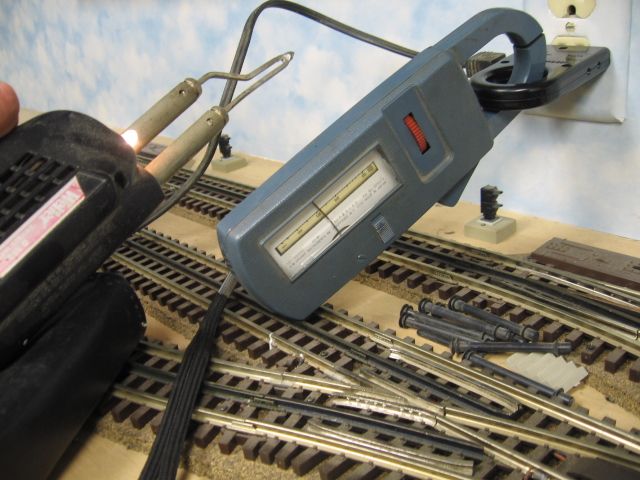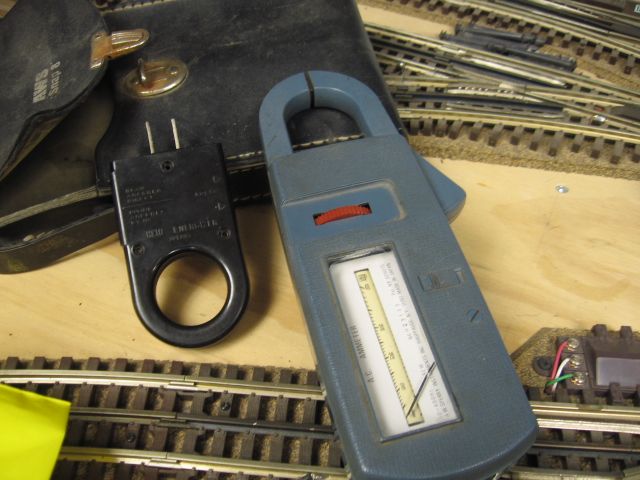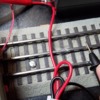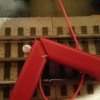I feel horrible for even asking for help on this but I can't get my meter to measure current on the workbench test track. Attached it a few pictures. Sorry for such a basic question. Note that the legacy power master in the photo is not working.
Replies sorted oldest to newest
Pictures don't help, I don't see where you have the meter connected to anything. Does the 180 watt brick work? Is the track connected to the PM? and the 180 Watt brick powering that?
cjack posted:Pictures don't help, I don't see where you have the meter connected to anything. Does the 180 watt brick work? Is the track connected to the PM? and the 180 Watt brick powering that?
The brick works fine, the track is connected to the PM. Yes, the brick is powering the PM. I don't have the meter connected as I'm unsure how to connect in this circuit.
OK. I think you need to encircle a wire going to the center rail with the loop on the meter. Set the meter to the lowest current. What's that little button on the right side? Do you have to press that to read current. And of course, you need to have a load on the track. A passenger car with lighting in it should draw enough current to show a reading on the meter. It probably would read about 0.4 amps AC or so.
cjack posted:OK. I think you need to encircle a wire going to the center rail with the loop on the meter. Set the meter to the lowest current. What's that little button on the right side? Do you have to press that to read current. And of course, you need to have a load on the track. A passenger car with lighting in it should draw enough current to show a reading on the meter. It probably would read about 0.4 amps AC or so.
I'm unsure what you mean by encircle a wire part, a little clarification please. The button on the side is a peak hold.
Heres how I have it wired.
Attachments
Thread the wire from A to center rail thru the plastic loop on the meter.
Trainlover9943 posted:Heres how I have it wired.
That's fine for reading the voltage. But to read the current, a single wire goes thru the loop. I'm not sure if you know all this or not. Are you really just trying to measure voltage and there is none because the pm or the brick is not working?
cjack posted:Thread the wire from A to center rail thru the plastic loop on the meter.
Like this?
Attachments
To read the current draw, a wire from the power source to the track has to be passed through the loop on your meter, and the meter set to measure current. Alternately, the meter can be hooked up with the probes by moving the red probe into the far right socket. One wire from the power source gets connected to the outside track. The other wire from the power source gets connected to one of the meter wires, and the other meter wire gets connected to the track center terminal. The meter must be set to read current before you turn on the power, or you will damage the meter.
Larry
cjack posted:Trainlover9943 posted:Heres how I have it wired.
That's fine for reading the voltage. But to read the current, a single wire goes thru the loop. I'm not sure if you know all this or not. Are you really just trying to measure voltage and there is none because the pm or the brick is not working?
I'm new to measuring current. I've figured I might as well learn sooner or later. I know how to measure voltage, current is all new to me.
Just clamp the meter around one of the wires going from the PM to the track. Don't use the meter leads at all.
Current is measured indirectly with a "Clamp meter" the large loop at the top of the meter.
Measuring the (AC) current two black wires inside the blue loop top of meter.


There is a loop attachment that allows for measuring plug-in tools, also. Measuring the AC current used by my soldering gun.


Older analog meter pictured, new meters have digital displays, but still use the magnetic loop measure system, which is accurate.
When all else fails read the instruction book that came with the meter. Best wishes, Mike CT.
Meter pictured dates to the late 1970's ![]()
![]()
![]()
Mike CT posted:Current is measured indirectly with a "Clamp meter" the large loop at the top of the meter.
Measuring the (AC) current two black wires inside the blue loop top of meter.
There is a loop attachment that allows for measuring plug-in tools, also. Measuring the AC current used by my soldering gun.
Older analog meter pictured, new meters have digital displays, but still use the magnetic loop measure system, which is accurate.
When all else fails read the instruction book that came with the meter. Best wishes, Mike CT.
Meter pictured dates to the late 1970's
Cool. My meter didn't come with instructions I don't think ![]()
My meter uses the top clamp (loop) to measure amps. To measure the draw only put the hot wire inside the loop. Be sure to set your meter on 'amps'.
Volts x amps = watts
Bill DeBrooke posted:My meter uses the top clamp (loop) to measure amps. To measure the draw only put the hot wire inside the loop. Be sure to set your meter on 'amps'.
Volts x amps = watts
I'll try that. And put the common wire to the track?
Trainlover9943 posted:Bill DeBrooke posted:My meter uses the top clamp (loop) to measure amps. To measure the draw only put the hot wire inside the loop. Be sure to set your meter on 'amps'.
Volts x amps = watts
I'll try that. And put the common wire to the track?
No, you need do nothing with the common wire. You should be able to get a reading without using, the black and red wire leads, that came with your meter.
Mike CT posted:Trainlover9943 posted:Bill DeBrooke posted:My meter uses the top clamp (loop) to measure amps. To measure the draw only put the hot wire inside the loop. Be sure to set your meter on 'amps'.
Volts x amps = watts
I'll try that. And put the common wire to the track?
No, you need do nothing with the common wire. You should be able to get a reading without using, the black and red wire leads, that came with your meter.
Still no dice. I have it wired correctly right?
Attachments
I can't see the rest of that red wire, but no it doesn't look right. With a clamp-on ammeter, the wire goes through the ring. From the picture, it looks like you have the end of the wire being held by the clamp on meter.
Here's a decent picture of a clamp on ammeter in use...
Attachments
Gilly@N&W posted:I can't see the rest of that red wire, but no it doesn't look right. With a clamp-on ammeter, the wire goes through the ring. From the picture, it looks like you have the end of the wire being held by the clamp on meter.
Does this looks better.
Attachments
Adriatic posted:Exactly like MikeCT shows in his first photo. Leads only measure Volts and Resistance in Ohms You have a meter that reads amps a little differently than what you may have seen or used in the past. Your's can safely read many more amps than the average multi-meter of the past.
Awesome. I'm just having trouble connecting it.
Trainlover9943 posted:Gilly@N&W posted:I can't see the rest of that red wire, but no it doesn't look right. With a clamp-on ammeter, the wire goes through the ring. From the picture, it looks like you have the end of the wire being held by the clamp on meter.
Does this looks better.
Nah, bud that's wrong. You don't clip onto the end of the wire with the meter. Let's simplify this. Do you have a conventional transformer? Just connect the transformer to your track lockon. Then take your clamp, squeeze to open and the put it over the hot lead. The wire should be passing through the ring like in the picture I posted above.
Try this video. It may help.
Consolidated Leo posted:Try this video. It may help.
Thanks. I got it to work.
Thanks for the help guys. I got it ![]() I feel bad having to ask though.
I feel bad having to ask though.
Don't feel bad about asking. Too many folks wish to contribute to repay for what they have also learned here... Would you deny them tbat? ![]()
A simple way to measure current is to place a 1 ohm precision resistor in series with the feed from the power source to the load. The voltage measured across the resistor will be equal to the current in amps.
BOB WALKER posted:A simple way to measure current is to place a 1 ohm precision resistor in series with the feed from the power source to the load. The voltage measured across the resistor will be equal to the current in amps.
Well, that's "simple", but think about it in the track power application, which is what we're talking about here. Turns out it's neither simple or suitable. Simple is the clamp-on voltmeter, just clip it around one wire and take the reading. No power loss, and no splicing in anything.
Say I'm using, say five amps for my train and supplying the track with 18 VAC. The resistor will drop 5 volts and I'll only have 13 volts of track power left! If I used even more power, I'd be dropping even more voltage. Another point is that the resistor is going to have to be a pretty healthy one, for the 5A example it's dissipating five watts, so it'll have to be at least a 10W rating.

















